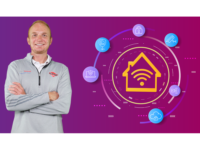Traditional security and the smart home are the same. There — I’ve said it. Our industry likes to see them as different, but for someone growing up now, without any preconceptions of alarm systems, they all just look like a lot of gadgets for the home. So what does this mean for the smart home and traditional alarm monitoring?
One way of viewing these smart home systems is using Maslow’s hierarchy of needs. Unless they take care of the basic needs first (security and safety), then the higher needs aren’t of much concern or satisfaction (esteem and self-actualization/ convenience and innovation).
The most effective and popular smart home devices help to fulfil those basic needs. Devices like thermostats and cameras provide notification to consumers, and allow them to evaluate the situation and respond as needed.
This is monitoring in a nutshell, and our industry is well positioned to provide valuable core services and product differentiation.
That doesn’t mean that monitoring stays the same as it is today; monitoring must evolve to take advantage of the vast amount of new devices and data, and make use of new analytics, connectivity and remote access.
Monitoring must change to provide new convenience services and perform more direct intervention and de-escalation of situations. In turn, monitoring can help shape the smart home in thoughtful ways to become truly more helpful.
Some examples of this would be for an agent to answer a video doorbell if the customer wasn’t available, or using outdoor cameras with speakers to allow an agent to announce they are watching when an intruder enters a yard.
Something as simple as using a flashing smart light bulb outside to allow responders to more easily find the home can make a big difference, and all of these systems can provide detailed information to customers, agents and first responders for improved situational awareness, safety and better response.
There hasn’t been a more exciting time or as many opportunities for monitoring as there are now. I encourage you to use your imagination and take advantage of the potential, and join other monitoring professionals in organizations like TMA and PPVAR to share ideas and help shape this future.







